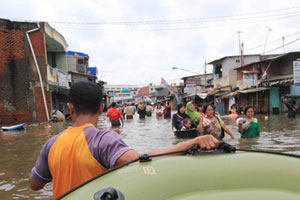Disasters have a way of testing friendships.
On the morning of January 17, 2013, when flood waters began to rise in Jakarta, this test arrived at my door. A huge storm that started in the middle of the night became more intense, adding more water to a city already saturated by days of rain. All indicators, such as water levels in key flood-gates and weather radar images, showed that a major flood was coming.
I called up our friends at the Provincial Disaster Management Agency, or BPBD. They are a fairly new team, having been established in 2011. Some in the team have dealt with natural disasters of a similar scale, but the last big floods in Jakarta occurred five years ago.
I remembered my own experience working through some natural disasters -- and Indonesia has its fair share of them -- and how thankful I was whenever someone offered help. I asked the team at BPBD: Would you like some help?
Knowing that the worst may be yet to come -- at the time, the flood waters were several hours away from reaching the Presidential Palace -- they said yes.
We then called a group of students from the University of Indonesia who previously helped BPBD, in conducting participatory mapping using Open Street Map -- a participatory mapping process where local residents can contribute in mapping certain parts of their area -- with funding and guidance from the Bank. They were eager to lend a hand, particularly as they knew what the BPBD would need and would not distract the BPBD staff from the crisis they were handling.
It took the students several hours to reach the BPBD’s Emergency Coordination Center, because the floods had halted train service, forcing them to walk through flood waters to get to the agency’s Situation Room.
Once there, the volunteers worked around the clock, in four shifts, surveying the situation. They managed the flow of situational information, especially geospatial distribution of the floods’ impact, and of assistance needs. They offered much-needed relief to the BPBD team, many of whom had barely slept in recent days. The BPBD stayed steady commanding the helm, reassured that they were not alone facing this crisis.
Realizing that the students would not likely make it back home, our team booked hotel rooms nearby the BPBD office, so that the team would be back at the BPBD the next day without having to face logistical hurdles. My trusty colleague Rinsan and I ventured to the BPBD office as well early the next morning, if only to provide moral support and a few practical suggestions. Getting to the BPBD’s quarters was not easy and some of the travel involved journeying through inundated streets.

To see the full impact of the flood disaster, a raft was recommended. But we did not spend too long surveying the sites as it became evident that others needed the raft much more than we.
The following Sunday, my colleague Ruby and I ventured to the heavily flooded area of Pluit, taking a raft to see firsthand the flood impact. It was a challenge just to get there. But it was nothing compared to the misery many Jakarta residents felt during those terrible few days -- at the height of the crisis, some 30,000 people filled emergency shelters on higher ground. Being at the side of our friends and partners was the least we could do.
Some colleagues have commended our team at the Bank for our response. I appreciate the praise, but our response is mere partnership at work. Partnership has been so important to our work at the Bank, whether it manifests in the form of donors coming together in times of crisis, or in the form of city residents banding together to assist their neighbors when trouble strikes. If crisis has a way of testing friendships, I hope we passed the test for our friends and partners.
How do you respond to emergency situations such as natural disasters? Do you have your own examples of helping others in times of catastrophe?
Blog post courtesy of Iwan Gunawan, Senior Disaster Risk Management Specialist, East Asia and Pacific Region, The World Bank. For more information, please contact Christina Irene at cirene@worldbank.org.
